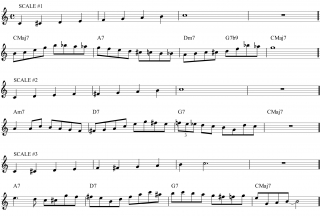Some months ago I shared a table of non-diatonic tones and their common uses. This morning I found myself thinking once again about non-diatonic tones, and specifically about an effective way to practice them, one that could quickly translate to actual jazz improvisation.
The standard bebop scales came to mind. The insertion of one extra note into a scale–typically a raised fifth in a major scale, and a raised seventh in a dominant (Mixolydian) scale–does more than allow a soloist to move through a scale with ease and land on an octave. It also creates new harmonic possibilities. That principle can be exploited by inserting other tones that also suggest secondary harmonies.
Click on the image to your right to enlarge it. You’ll see three scales. The first two contain a single added note. Scale #1 includes a raised first, and scale #2, a raised fourth. The interpolation of these notes adapts a basic major scale for use with two commonly encountered secondary dominant chords: the V7/ii (or VI7) and the V7 of V (or II7). In the key of C, which these scales are written in, those chords are A7 and D7.
These scales are as fresh to me as they are to you at the time of this writing. Not that I’ve never played them before; I just haven’t made a conscious point of focusing on them as actual scales to invest my time in practicing. I see two benefits to doing do. The first is, obviously, developing technical facility. The second is raising one’s awareness of the added notes as harmonic devices, with an eye on the secondary chords that they apply to.
Each added note serves as the major third–a critical identifying tone–of its secondary dominant chord. So when you play scale #1, remember that it works readily with the VI7; and likewise, scale #2 pairs with the II7. Many playing situations feature both of those secondary dominants, and often the VI7 moves directly to the II7, which in turn moves to the V7–in essence, coasting around a segment of the cycle of fifths.
The third scale incorporates both the raised first and the raised fourth, making it a kind of granddaddy scale that accommodates both secondary dominants.
Now, don’t look at these scales as magic harmonic bullets.. Rather, look at them as resources that allow you to judiciously select certain tones when you need them as well as furnishing you with good linear resources. It’s not all about your fingers mastering the technique of the scales. It’s also very much about applying your mind to grasp the uses of the introduced tones.
In other words, build harmonic awareness, not just digital dexterity. To assist you, I’ve included an exercise for each scale that will help you hear how each added note implies a certain harmony. Play these exercises on the piano so you can chord along with the melody line, or else get a keyboard player or guitarist to comp for you while you play the different lines.
Have fun! And if you enjoyed this post, drop in on my Jazz page and check out the many other exercises, articles, and solo transcriptions.


